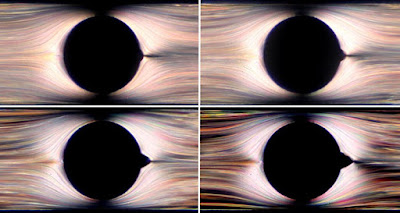The formation and subsequent collapse of bubbles has been seen for the first time in a flowing liquid crystal. This process is called cavitation and occurs when the pressure drop in a flowing fluid is large enough to allow some of the fluid to vaporize and create a bubble. Cavitation is of great interest in hydrodynamics because the collapsing bubbles can dissipate large amounts of energy in small regions and cause significant damage to machinery such as propellers.
The discovery was made by Tillmann Stieger and colleagues at the Max Planck Institute for Dynamics and Self-Organization in Göttingen, the Technical University of Berlin and the ETH Zürich. Liquid crystals are fluids that are made of rod-like molecules that tend to align under certain conditions. In its experiments, the team pumped liquid-crystal fluids through tiny channels just 0.1 mm wide. The channels contained obstructions, which increase the speed of the flow and encourage cavitation (see image).
Bubble cavitation spotted in liquid crystals, Hamish Johnston, Physics World

Comments